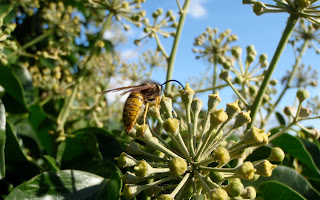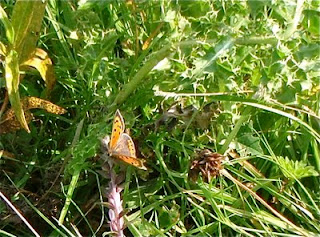As soon as frosts start and this source of food becomes scarce then fruits, berries and nuts will be consumed. Hopefully this winter there will be plenty for all, including migrants from the frozen north.
Ivy forms a valuable food source during the winter as flowers and then berries sustain wildlife and the evergreen leaves provide shelter for many species.
Song thrushes were singing loudly after overnight rain on 30th December 2011, three of them at least.
It was great to hear from John R. before the year was out that he had seen a barn owl hunting at about 15.45 on Wednesday 28th December! A confirmation that our local wildlife is surviving.
Tuesday 27th December was a typical day for this winter, very dull and overcast but dry, with no wind and no sign of the cloud clearing. A glance at the riverside revealed a beautiful tiny goldcrest foraging for insects amongst the fine twigs on an old oak, easy to distinguish it from the numerous blue and great tits foraging in the same area by it's behavior and size rather than colouring in the very poor light. A male bullfinch, 4 chaffinch, 2 greenfinch, 5 robins, at least 5 goldfinch and 4 wrens were also foraging in nearby thickets close to the river, a green woodpecker 'jaffled' loudly and a great spotted woodpecker flew low overhead. Soft calls reavealed some fieldfare entering the blackthorn whilst two nuthatch were busy in another oak, probing the bark with their strong bills, in search of insects. Two probable treecreepers flew down to the roots of trees and were seen making their way swiftly upwards and around out of sight. At least 10 blackbirds were seen on the river banks searching amongst fallen leaves.
Sunday 18th December was the day of our conservation group meet on the river:
A cold frosty start with song thrush singing loudly, many robins with some singing and about 10 wrens but only one or two trying out short songs. Blackbirds were active all along the riverside foraging silently amongst the fallen leaves with only an occasional alarm call. Redwing were the stars today - a group had arrived and spread out amongst the thickets along the riverside where Hawthorn, Blackthorn and Holly berries and fruits were the attraction. A fine close view of one redwing posing with a holly berry in its beak, a rare sight as they are wary birds. The thickets also held assorted finches, greenfinch, goldfinch and chaffinch. A small group of long-tailed tits, fluffed up against the cold, were seen amongst the numerous roving groups of great and blue tits. Sentinel woodpigeons sat high in the trees, ready for flight at the slightest disturbance below. Here and there they were accompanied by crows, starlings and a jay. A flash of orange then brilliant blue along the river - a kingfisher speeding around the corner. In a sheltered spot a dunnock was seen foraging low amongst the roots and a bright male bullfinch flew up from a bramble patch. A house sparrow colony was chattering in a hawthorn hedge whilst two treecreepers and then a nuthatch were seen searching for insects in the bark of mature trees.
On 9th December, a fine sunny day to start with the squirrels were foraging and seeking a varied diet:
This grey squirrel plucked a whole mushroom and carried it to a sunny spot on an old log where it enjoyed its meal. Obviously this was a delicacy as there were still plenty of nuts and acorns to be had.
On 6th December, several redwing were seen flying low along the river vegetation, no doubt marking the trees and thickets that held berries and fruits.
Monday 5th December was an unusually very cold clear day with early frost bringing out the foraging birds. Just a quick look along the river showed a male blackcap, 2 nuthatch, 2 bullfinch with a great view of the large vividly coloured male calling (rather loudly for a bullfinch) first before leaving the thicket to forage on the river bank. A female was seen close by. A jay called loudly and a 'charm' of about 25 goldfinches flew over to others occupying a thicket. 5 Blackbirds, 2 chaffinches, a dunnock, 2 songthrush were seen and 2 robins out of several more were singing. On the opposite side of a thicket at least 4 fieldfares were feeding with numerous great tits and blue tits foraging along the river. A colony of house sparrows was chattering as usual inside a hedge.
Holly berries on a young tree - one day they were there and the next day they had disappeared, eaten by hungry migrant redwings from the famine of frozen Scandinavia, pausing for a while to feed and then move on.









































